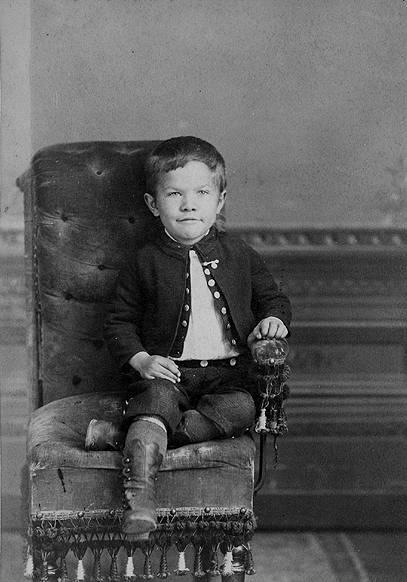
Figure 1.--This unidentified cabinet card shows a boy wearing a cut-away jacket suit with knee pants. It is undated, but looks like the 1870s to us. Notice how he has crossed his legs. |

|
Most of the early images are formally posed, with the subjects stiff and static. Over time, poses became less formal. Here emulsion speeds were a factor. The posture assumed by the children may provide some clues as to gender. Posture is an indicator that we have not given much attention to you. A reader has pointed out that this is a possibly useful indicator that HBC should address. There are several posture variables. The two basic posture alternnatives are standing and sitting with a few children laying down. Many images are just the children standing square shouldered before the camera. There are no gender indicators here. A few children are standing, but with one of the feet cocked up in a rather jaunty way. A good example is an unidentified French child. We are not sure yet, if there are any gender connotations here or if so, what they were. The other basic posture here is sittibng down. Often the children simply have their legs hanging down. There is no gender connotation here. The children often cross their legs. In fact, I think that girls were often taught to cross their legs demurely at the ankles when sitting down. We believe that more agressive crossing of the legs, especially at the knee, suggests that the child may be a boy. A good example of this is an unidentified American child wearing a dress. We are still assessing this indicator and welcome reader comments. A reader tells us, "I think you are correct here. Boys were much more likely to cross their legs. Girls were taught from an early age not to cross their legs beyond what you mention as crossing the ankles. It was seen as unladylike!"
There are several posture variables. The two basic posture alternnatives are standing and sitting with a few children laying down. Many images are just the children standing square shouldered before the camera. There are no gender indicators here. A few children are standing, but with one of the feet cocked up in a rather jaunty way. A good example is an unidentified French child. We are not sure yet, if there are any gender connotations here or if so, what they were. It should be recalled that the woman's ankle was at the time considered rather risque and rather titilating. This was not the case for girls. We are not sure just what the age conventions were, but certainly by the mid-teens this was the case. We have just begun to assess this topic. There may be other ways of diferentiating standing postures with gender connotations. We welcome any reader insights here.
The other basic posture here is sitting down. Often the children simply have their legs hanging down. This seems to be the most commion sitting posture. There as far as we can tell no gender connotation here. The children also often crossed their legs, while this was not the most common posture, given the number of photographic portraits, we have found large numbers of such images. This may have been more common for boys, but we can not yet confirm that.
We think that there were basically three alternatives here: crossing the legs at 1) the ankles with calves apart, 2) crossing at the ankles with the the calves toether, and 3) crossing at the knees. Logically you might think an alternative is criossing art the calves, but phyically this is not a natural alternative as it requires mussle tension to hold them there .
We are not sure how common criossing legs at the ankl with calves apart was. We suspect this was mostly a boysish posture.
We note many girls with their legs crossed at the ankles with the calves together. In fact, we think that girls were often taught to cross their legs demurely at the ankles when sitting down. A reader tells us, "I think you are correct here. Boys were much more likely to cross their legs. Girls were taught from an early age not to cross their legs beyond what you mention as crossing the ankles. It was seen as unladylike!" That does not mean that all children that crossed their ankles were girls. See for example an American boy, Richard Crown. Another example is John Seagrum, we think in the 1870s.
We believe that more agressive crossing of the legs, especially at the knee, suggests that the child may be a boy. A good example of this is an unidentified American child wearing a dress. We are still assessing this indicator and welcome reader comments. It does seem to indicate that children who crossed their legs an the knee were mostly boys.
We note some children with a variety of phrone postures. We think this was more common for boys than girls, but we can not yet confirm this.
Navigate the Boys' Historical Clothing Web Site: Navigate the Boys' Historical Clothing Web Site:Sitting Poses
Prone Poses
HBC
[Return to:Main photo gender guide page]
[Return to:Main photo guide page]
[Return to:Main photography page]
[Introduction]
[Activities]
[Biographies]
[Chronology]
[Clothing styles]
[Countries]
[Bibliographies]
[Contributions]
[FAQs]
[Glossaries]
[Images]
[Links]
[Registration]
[Tools]
[Boys' Clothing Home]
[Dresss]
[Sailor suits]
[Sailor hats]
[Buster Brown suits]
[Eton suits]
[Rompers]
[Tunics]
[Smocks]
[Pinafores]
Created: 1:21 AM 7/26/2011
Last updated: 1:21 AM 7/26/2011
